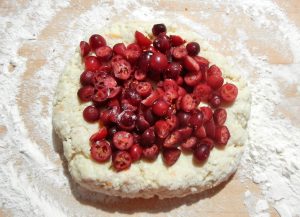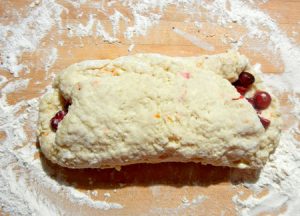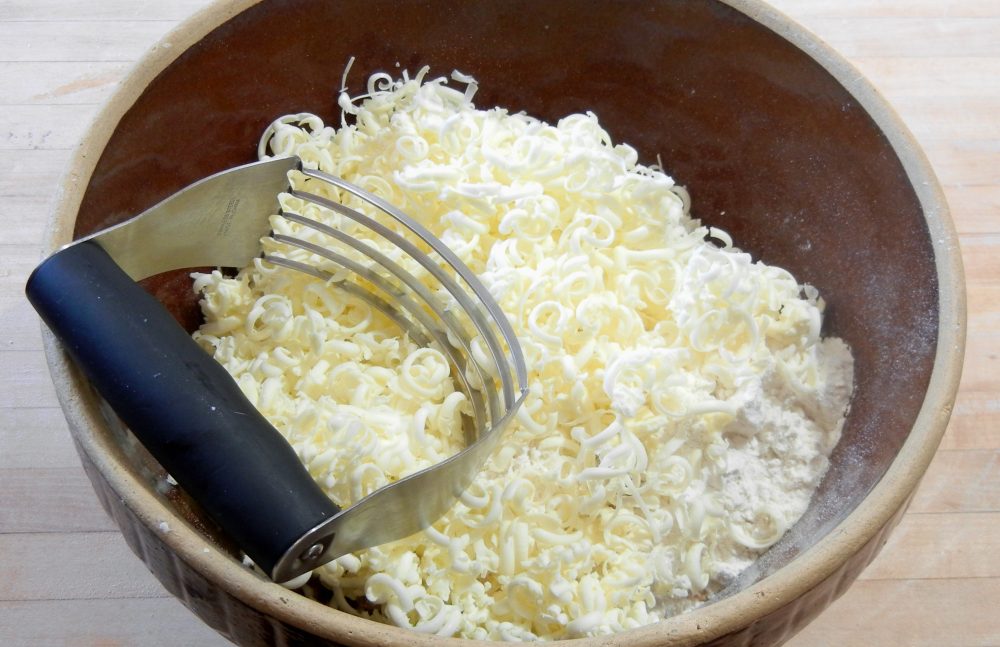How do I add fruits to either the Original Recipe or Original Oatmeal scone mixes without crushing the fruit?
 I learned this one the hard way. Do NOT add your fruits to the dough in the mixer, but wait until you have patted it out on the board, and have divided it into the 2 balls. At this point, place your soft fruits on the top of the dough.
I learned this one the hard way. Do NOT add your fruits to the dough in the mixer, but wait until you have patted it out on the board, and have divided it into the 2 balls. At this point, place your soft fruits on the top of the dough.
Then, gently fold the dough over on itself, and GENTLY* re-work the dough into a circle of dough. The fruit will work itself into the body of the dough, evenly distributing the fruit throughout the dough.
Cut the dough into wedges, and either freeze the dough for baking later, or bake immediately.
**a word of caution as you work the fruit into the dough. Scone dough, like biscuit dough, prefers very minimal, gentle handling. Unlike bread dough, where the more it is kneaded, the better the bread; scone dough becomes tougher with continual working and handling.
You recommend frozen butter…Why?
Ideally you want to see little nubbins of butter in the mixture prior to adding the buttermilk. These little nubbins will melt when they hit the oven, creating a pocket of steam, which helps with the rise of the dough. They also help create the lovely air pockets in the dough, which again, adds to the lightness of the scone.
 Adding frozen butter can be problematic. By far the easiest way I have hit upon to do this is to grate COLD butter (using a cheese grater, or a food processor) onto a piece of foil or wax paper, and then freeze it for 20-30 minutes. If I am on a scone making binge, I’ll often put several packages of grated butter (each package holds the amount needed for one recipe) into the freezer one evening—and then the next day start making and freezing scone dough.
Adding frozen butter can be problematic. By far the easiest way I have hit upon to do this is to grate COLD butter (using a cheese grater, or a food processor) onto a piece of foil or wax paper, and then freeze it for 20-30 minutes. If I am on a scone making binge, I’ll often put several packages of grated butter (each package holds the amount needed for one recipe) into the freezer one evening—and then the next day start making and freezing scone dough.
I promise—cutting in frozen grated butter with a pastry cutter is a snap—so quick, so easy—you’ll wonder where it went!
What is the shelf life of Victorian House Scones mix?
All Victorian House Scones mixes should keep well for a year. If you anticipate that they will be stored longer, or you live in a very warm or humid climate, you can increase the shelf life by putting the bag of mix into a zip-lock freezer bag, and storing it in the freezer. If you do this, allow the mix to return to room temperature before use.
How big is one scone?
To illustrate the size of a single scone—put your hands in front of you and completely overlap your thumbs. Put the tips of your index fingers together. The enclosed triangle is the size of a single scone. You may, of course, choose to cut your scones into any size or shape you wish—and then adjust your baking time accordingly.
What if I want to make them smaller (or larger)?
Go for it. You can make them any size, shape, etc. that your heart desires. The only two things you need to remember are to keep the dough 3/4-1” inch thick, and keep an eye on your baking time the first time you try it. These are very versatile; experiment to your heart’s content.
This makes a lot of scones. Can I freeze the dough?
Yes, absolutely. We have in-depth instructions on our Mix instructions page.
Can I make only half the bag?
No, you really can’t. Because each of our mixes is hand-packed one ingredient at a time, it is a “layered” mix. You would have to blend the entire bag of mix to ensure that all components are distributed evenly—and then measure out half, and so on. This is why we strongly advise you to make up the entire bag of mix, and freeze the dough as individual ready-to-bake scones. You only dirty the bowl once, and can bake as many or few as needed, when needed. See the detailed directions on our Mix Instructions page.
Do any of Victorian House Scones mixes contain either nuts or dairy products?
Our Butter Brickle mix is the only mix that has both in the mix itself. It includes Heath Bits ‘o Brickle, manufactured by Hersheys’ foods. The brickle is made from butter as well almonds, and carries an allergen warning that it was manufactured in a plant which processes peanuts. If this is a concern, please avoid this flavor.
All our mixes require the addition of butter and buttermilk—so if you are dairy intolerant, you can substitute as needed.
Can I substitute for butter?
Yes, and you have several options. If you truly can’t use butter—you can add a high quality baking margarine, or other sort of vegetable shortening. Be sure to chill it down well—(or freeze it slightly) before adding. See our blog posting on the benefits of frozen butter.
I don’t have buttermilk. Can I substitute?
Yes, of course. Powdered buttermilk works well — simply reconstitute following package directions. If you don’t have that, you can use the old stand-by of vinegar or lemon juice in regular milk. This works best if you have at least 2% or whole milk. Add 1T vinegar or lemon juice to a measuring cup, than fill to 1 C with milk. Allow this to stand for 5-10 minutes, and then use. If you are making Lemon Poppyseed scones, you will still need to add the lemon juice to the dough.
I’m vegan—can I still use this mix?
Of course you can—and we have the vegan substitutions up on our Mix Instructions page (credit to Janis Badareau of Tea Guide for sharing her secrets with us.
My scones didn’t rise very high.
Most likely, you patted your dough out too thin. Scones are essentially a biscuit, and will rise to about double the thickness of the raw dough. Pat your dough out to a thickness of 3/4-1 inch thickness, and they should rise just fine. If they spread more than rise, it is also an indication of warm room conditions—an easy fix is to chill or freeze them while you are waiting for the oven to preheat .
Why should I use parchment paper?
Part of the reason for lining the baking sheet is to help with clean-up. If you sprinkle the top of the scones with sugar or cinnamon sugar, it will end up on the baking sheet, and most likely burn slightly and make clean-up difficult. Parchment paper will prevent this.
Parchment paper is also a good indicator of oven temperature. See the following Q/A for a complete explanation of parchment paper and oven temperature.
My scones are too dark/burned on the bottom. What can I do?
There’s a very slick, easy way to prevent this—double up your cookie sheet!! But, it is also worth looking at some of the other reasons you may be seeing scorched scones.
Scorching can be caused by a number of factors. Start by double-checking that your oven temperature is correct. If this is a consistent problem with all baked goods, consider getting an oven thermometer and calibrating your oven. If you use parchment paper, this is a good indicator of oven temperature; if it comes out of the oven “tanned”, the oven is too hot. If you don’t have an oven thermometer—and no time to get one, an easy fix is to simply drop the temperature 25 degrees. The scones will bake just fine, but may take a bit longer.
Since the scone dough has a fairly high butter content, if the dough gets warm while you are waiting to put it in the oven (such as setting it on top the stove while the oven pre-heats), you can cause some melting of the butter, which will then burn while baking. Don’t put the scones onto the cookie sheet or parchment paper until you are ready to place them in the oven. If you are baking from frozen dough, wait until your oven is pre-heated before getting them out of the freezer! No proofing is needed!
I prefer a more intense pumpkin flavor in my Pumpkin Spice scones. What can I do?
The recipe calls for 1/3 cup canned pumpkin and then enough buttermilk to make 1 cup . You may increase the amount of canned pumpkin to 1/2 cup and then sufficient buttermilk to 1 cup. You may needed to adjust your baking time slightly, and this will make a slightly denser scone.
This is simply a listing of situations we’ve encountered. Of course you may have a question or problem we’ve not considered or thought of. If you had a problem you can’t explain don’t hesitate to ask the one who makes the mixes, [email protected]; if you’ve found solutions unique to your problem, we’d love to hear all about that too.

 Cart
Cart